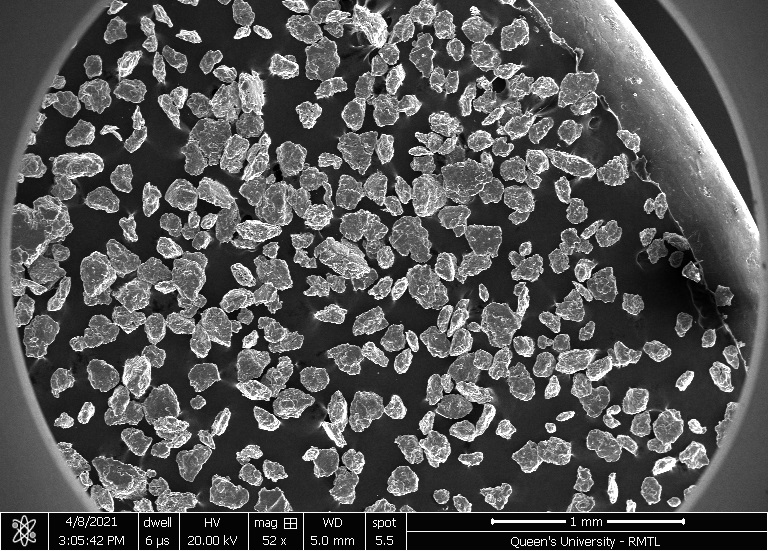Canadian Nuclear Laboratories (CNL), Canada’s nuclear science and technology organization, identified a new magnesium-based alloy that promises a significant improvement in hydrogen storage. The idea is to use a catalyst to bind the hydrogen to the alloy. When heated, the hydrogen is then released. “While the specific chemistry remains part of our ‘secret sauce’ so to speak, we have developed a magnesium-based composite which is proving in testing to be a very promising material for hydrogen storage purposes,” research scientist Brian Ellis said in a press release on Tuesday. According to CNL, the new alloy is capable of storing “just a little over 6% of its weight in hydrogen.” Researchers say that the development might be prohibitive for small passenger vehicles, but an advantage in heavy equipment. “A hydrogen-powered passenger car currently carries approximately 10 kilograms of hydrogen (as a compressed gas) to allow its full operating range. That same 10 kilograms of hydrogen stored in metal would weigh upwards of 150 kilograms,” CNL stated, adding that the magnesium-based alloy would, for instance, come in handy for fork lifts.
South Korean car parts company Hyundai Mobis announced a $1.1 billion (€0.95 billion) investment in two new fuel cell plants in Korea. The aim is to accelerate the hydrogen economy and “to secure broader global market dominance.” According to the South Korean public company, the new plants will start mass production in the second half of 2023. “When fully operational, the facilities are expected to produce 100,000 hydrogen fuel cells every year,” the company announced on Thursday. Hyundai Mobis already operates one fuel cell plant in Chungju with a capacity of 23,000 hydrogen cell systems a year. “We will continue to invest more in facilities and strengthen our R&D capability for the development of the hydrogen industry and expand the ecosystem,” said Hyundai Mobis President and CEO Sung Hwan Cho. Current production mainly targets fuel cell EVs, but the company wants to also provide fuel cells to other sectors, mostly construction machinery and logistics equipment.

Image: Hyundai Mobis
U.S.-based hydrogen solutions company Plug Power and SK E&S, part of South Korea’s SK Group, formed a joint venture to accelerate the use of hydrogen as an alternative energy source in Asian markets. The scope of the collaboration will include hydrogen fuel cell systems, hydrogen fueling stations, electrolyzers, and green hydrogen. Earlier this year, SK Group made a $1.6 billion (€1.38 billion) capital investment in Plug Power. SK E&S and Plug Power will own 51% and 49% of the joint venture. Plans include the construction of a gigafactory in South Korea by 2024.
Spanish oil and gas major Repsol, which produced renewable hydrogen using biomethane as a raw material for the first time earlier this month, increased its targets for renewable generation and emission reductions. The company said it was increasing “investments in the 2021-2025 period to €19.3 billion, allocating an additional €1 billion over the period of the Strategic Plan to step up its renewable electricity generation capacity and production of renewable hydrogen, as well as other low-carbon initiatives.” Repsol plans to produce 552 MW equivalent of renewable hydrogen in 2025, and 1.9 GW in 2030. The company said it would achieve its objectives through the installation of electrolyzers and biogas production plants at its industrial complexes, as well as the development of photoelectrocatalysis technology. “This technology is a joint development of Repsol and Enagas, and a demonstration plant will be installed at the Puertollano industrial complex in 2025 to obtain hydrogen directly from water using solar energy,” the company said. Repsol announced earlier this week that it had produced 10 tons of renewable hydrogen from 500 MWh of biomethane at its Cartagena Industrial Complex.
South Africa’s integrated energy and chemical company Sasol signed a memorandum of agreement (MOA) with the Northern Cape Development Agency (NCEDA) to lead a feasibility study exploring the potential of Boegoebaai as an export hub for green hydrogen and ammonia. “The Boegoebaai ‘green hydrogen’ development has been designated a Strategic Integrated Project (SIP) in the South African National Development Plan and is located in the Namakwa Special Economic Zone (SEZ). The project’s location and classification as a SIP are key enablers to exploring Boegoebaai’s potential as a global green hydrogen hub,” the company wrote on Wednesday. It expects the feasibility study to take approximately 24 months. Sasol partnered with the Gauteng provincial government to leverage special economic zones and with the Industrial Development Corporation for joint funding. The focus should be on mobility for the local market and aviation for international markets. The project has the potential to produce 400 kilotons of hydrogen per annum, according to local media reports, which cited Priscillah Mabelane, Sasol's executive vice president for energy.
Australia’s Northern Territory government released its Renewable Hydrogen Master Plan to guide the development of a Northern Territory renewable hydrogen industry. “The Territory is well placed to position itself at the forefront of the developing renewable hydrogen industry with large areas of land, high solar irradiance, close proximity to export markets, and an established world-scale energy production and export industry,” the government said Thursday. The plan hinges on a two-step approach. The government first wants to support the early adoption of renewable hydrogen as a fuel source locally through transport corridors before scaling up to export it. It's also banking on large-scale geological storage. The Northern Territory represents around 15% of Australia’s total LNG production and export. It now wants to replicate, or even increase, this share of total Australian hydrogen production and export. “Darwin is the closest Australian capital city and deep sea port to key export markets such as Japan, Korea, China and Singapore,” reads the complete Master Plan.
This content is protected by copyright and may not be reused. If you want to cooperate with us and would like to reuse some of our content, please contact: editors@pv-magazine.com.



Very interesting, which has tremendous potential as future power ecosystems.